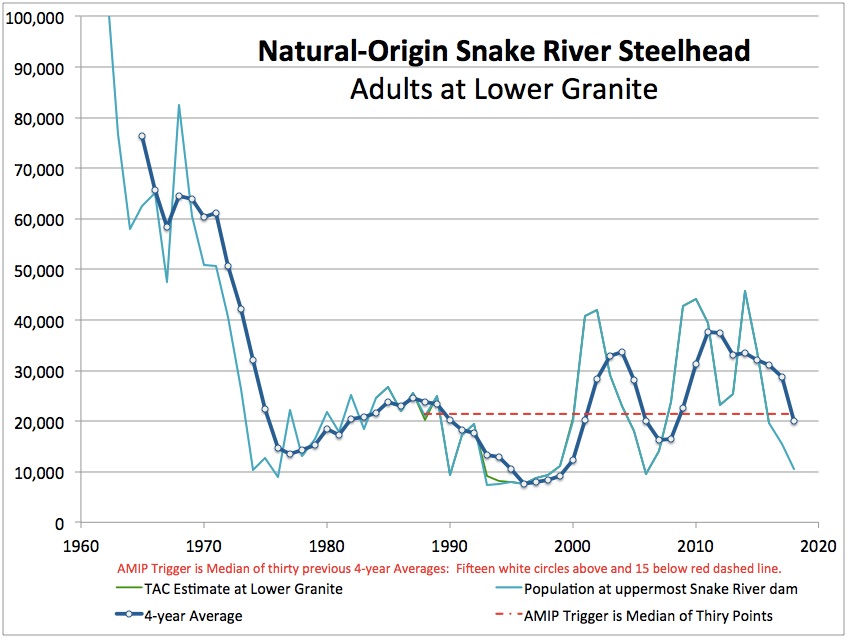forum
library
tutorial
contact

We Can Have Our Salmon
and Eat It, Too
by Walt Pollock
The Register-Guard, September 2, 2021
|
the film forum library tutorial contact |

|
We Can Have Our Salmon
by Walt Pollock
|
 Sustaining abundant runs of salmon, the Northwest's signature species, while meeting the region's electric power needs is a challenge I know well. During my 40-year career, I held senior management positions in public utilities and private energy companies where a central concern was the need to affordably and reliably supply electricity to our customers while conserving salmon.
Sustaining abundant runs of salmon, the Northwest's signature species, while meeting the region's electric power needs is a challenge I know well. During my 40-year career, I held senior management positions in public utilities and private energy companies where a central concern was the need to affordably and reliably supply electricity to our customers while conserving salmon.
This challenge is center stage right now on the Snake River, where the decades-long debate about whether we can have abundant salmon and clean energy is a red-hot political issue. The central questions are whether the four federally owned lower Snake River dams must be removed to recover the river's once prolific salmon, and, if so, whether the Northwest's power needs can still be met.
I believe the answer to both questions is "yes."
The heavy toll the four lower Snake River dams would take on salmon has been known since their construction was first considered. In a report from the U.S. Fish and Wildlife Service to the Corps of Engineers on a study initiated in 1944, the FWS said: "The lower Snake river dams present, collectively, the greatest threat to the maintenance of the Columbia River salmon population of any Project heretofore constructed or authorized in the Basin. Because of this, serious doubts have been raised as to the possibility of maintaining anadromous fish populations in the Snake River watershed."
That prediction has, unfortunately, proven true. Despite good intentions and a lot of money spent, Snake River salmon are on the ropes. There is broad agreement among scientists that for every 100 young salmon that migrate to the ocean, at least four need to return as adults to spawn and sustain Snake River runs. On average, fewer than two return. This puts the fish on a trajectory to extinction. And Southern resident killer whales, who rely in part on Snake River chinook salmon as a critical food source, are now imperiled.
The case is compelling that the lower Snake River dams must be removed to recover abundant and harvestable Snake River salmon -- a moral and legal obligation, secured through treaties, of the United States to Native American Tribes. But their removal must not come at the cost of a reliable northwest electric power system.
I believe we can recover Snake River salmon while meeting the region's power needs.
The lower Snake River dams play an important role in the Northwest's power system. In addition to the substantial amount of power they generate, they can be operated to meet short-term power needs when wind and solar resources can't, and they can generate power for up to 10 hours per day for five consecutive days during critical times, such as winter cold snaps.
The good news is smart investments, sound planning and updated agreements can replace the lower Snake River dams benefits. Terminating the antiquated treaty with Canada regarding operation of the Columbia Basin dam system, written in the 1960s, and replacing it with an agreement based on today's conditions and needs could replace half the power produced by the lower Snake River dams.
Optimized Columbia and Snake River hydro system operations, energy grid improvements, dispatchable standby generation and rapidly improving battery technology could be used to obviate the need for the lower Snake River dams, as could continuing investment in energy conservation programs.
These actions can result in an improved Northwest power system: one that is reliable, economic, renewable and fish-friendly, with no addition of carbon-emitting generation.
Idaho Congressman Mike Simpson started the discussion this year with a thoughtful, ambitious proposal for a solution that meets the needs of people and fish. Oregon Gov. Kate Brown deserves credit for supporting the Simpson approach despite criticism from defenders of the failed status quo.
The Northwest congressional delegation, including Congressman DeFazio and Sens. Ron Wyden and Jeff Merkley, hold powerful committee leadership positions, so now is the time for them to act boldly and help forge a comprehensive solution. The budget reconciliation bill now being written is a timely opportunity to secure funding that will be needed for such a solution, including essential analyses and planning.
A comprehensive plan should call for removing the lower Snake dams and set a course for replacing the benefits they provide. If it does, it will be a solution the entire Pacific Northwest can -- and should -- get behind.
learn more on topics covered in the film
see the video
read the script
learn the songs
discussion forum
